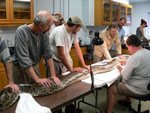
Sandia Laboratory and others will study microbial genes in arid grasslands.
Scientists in Switzerland say up to 35 percent of the total nanosilver in tested fabrics was released, mostly in the first wash.
SETI Institute and NASA are using a Zeppelin over San Francisco Bay to gather data for a predictive model of microbial ecosystem change.
Proposals must be received by Jan. 5, 2010.
The project is a model for demonstrating how reducing emissions from deforestation and degradation can be implemented.
Researchers identified offshore sand sources that could be used for future beach replenishment without causing a bigger erosion problem elsewhere, a USGS lead scientist says.
Although one critic says the model's sea level rise and subsidence rates were optimistic, he admits the model still predicts land could be delivered to the sinking delta.
Researchers are studying the genomes of uncultivated microbes found in OMZs to better understand how they participate in global geochemical cycles such as the carbon and nitrogen cycles.
Western Washington University study finds that tree leaves on busy diesel bus routes were more magnetic than those from rural areas.
NOAA provides $243,000 in funding for the development of safeguards for the Lake Sunapee Watershed against climate change effects and population growth.
The Tennessee Valley Authority has proposed restoration alternatives for aspects of the site cleanup that don't have to be addressed immediately.
A Georgia Southern University study analyzed stream water temperatures at six different golf courses in South Carolina.
Restore America's Estuaries is organizing a group of experts to develop a greenhouse gas offset protocol for wetland restoration projects.

Five large, non-native snake species may rattle Fla. ecosystem.
The Texas Department of Transportation announced that state has officially killed the I-35 Trans Texas Corridor by selecting the "No Build" option under the environmental impact statement study.
Company used erection gantry to drive pile and protect Pamlico-Tar River and wetlands.
Agreement, stimulus funds should help District of Columbia advance its environmental priorities.
A major goal is to develop new approaches to detect, monitor, predict, control, and mitigate harmful algae and their impacts in Texas coastal waters.